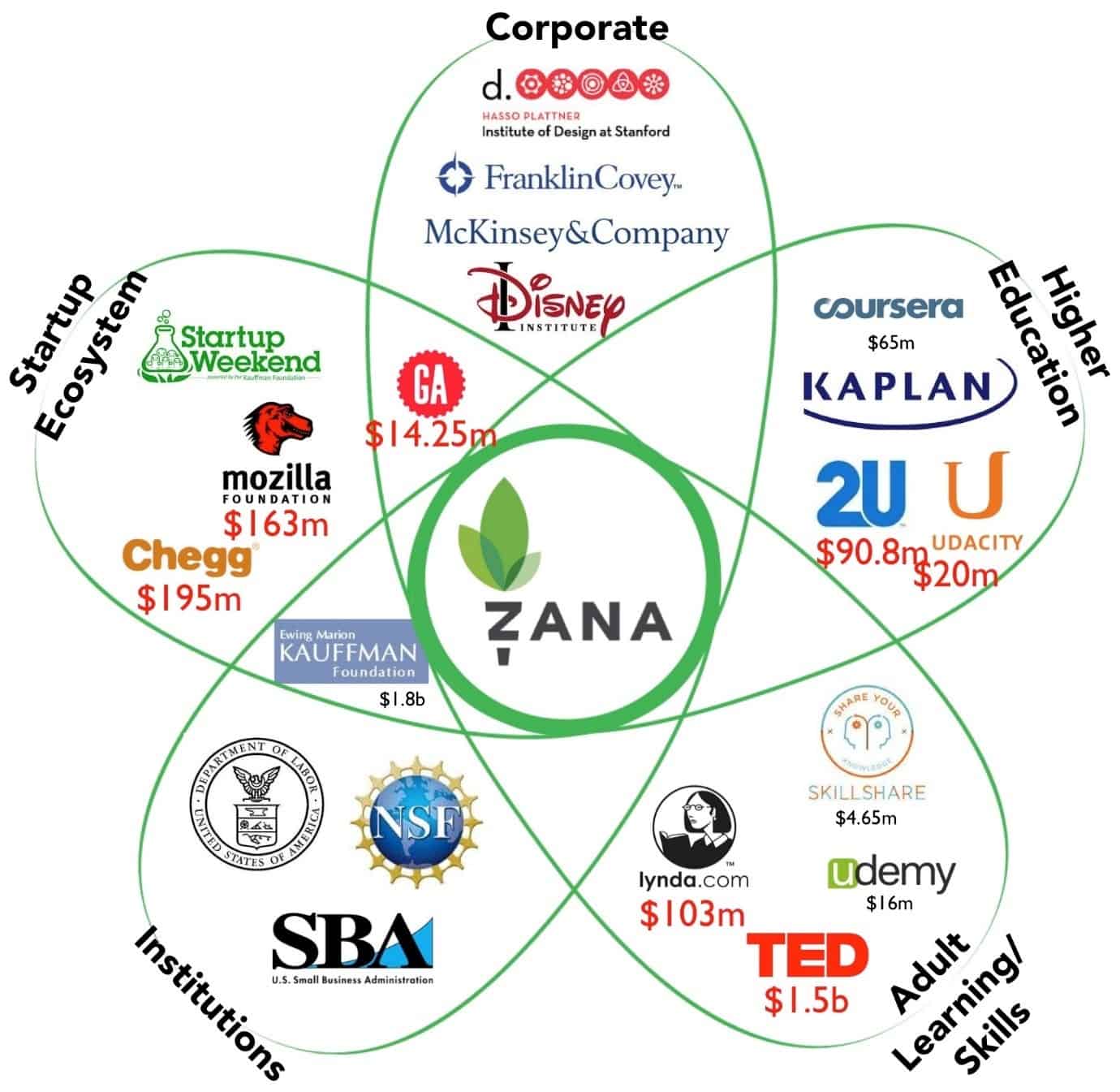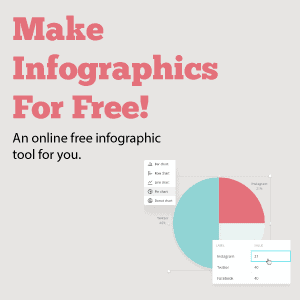Pitch Deck 101
An entrepreneur’s guide to pitch decks
The 12 Slides Of The Pitch Deck
So you’re an entrepreneur ready with a product, seeking some money to kickstart or expand your startup venture.
But let me get this straight – fundraising is hard. You need to predict what the investors look for in your startup and what would be the best presentation for you to persuade him.
But fret not, we’ve researched over 20 unicorns’ pitch decks that raised billions of dollars in funding, combined them with the guidelines provided by big VCs like Sequoia Capital and developed the best pitch deck template you can use for your startup pitch.
But before we start – here are answers to some questions that might trouble you while reading –
No. A pitch deck is means to tell your own story. These are only the recommended slides which can be arranged in any order as you wish. But do make sure that your attention and retention graph always points up and the next slide always answers the question that the current slide gives rise to.
For your email deck, yes. As you’re not present to clear any doubts an investor may have while reading the deck.
For your presentation deck, not really. But it is generally considered a good practice to give generic headings to your slides.
No. You can use as many as 4 slides to elaborate your stance. Uber used 6 pages to elaborate its offering in its pitch deck.
No, you don’t. The following list of slides is for the best-case scenario when you –
- Have a real customer traction
- Have some numbers to back you up
- Have calculated and predicted financials like the income statement, cash flow statement, etc.
However, if you’re just raising money in the pre-seed or seed round and don’t have a proof of traction, you can replace the slides with the most suitable replacements. Like – traction slide with the validation slide and the financials slide with the milestones slide.
Note:
This guide is huge. Fill this form to receive this article as a PDF .
Pitch Deck Slides
Generally, a startup pitch deck focuses on answering 12 major questions. These questions are translated into slides and includes data to support your answers. These questions/slides are –
- Intro
- Problem
- Solution
- Why Now
- Offering
- Market
- Competition
- Traction
- Business Model
- Team
- Financials
- Ask

Slide #1: Intro
“Who are you and why you’re here?”
Investors receive a lot of decks, so it is very important for you to give a clear picture of what your startup is all about in the first slide itself.
But keep it minimal.
The Purpose Of Pitch Deck Company Slide
Use this slide to –
- Establish your brand identity
- Answer the question – “Who are you?”
- Answer the question – “What’s your mission or purpose?”
- Provide your contact information
How To Create The Intro Slide?
Establish your brand identity in this first slide itself with your logo and your company’s purpose. Explain in brief – “How do you help your customers”.
Draft the copy in a way which intrigues them, get their attention, and want them to read more.
Here’s an example of the pitch deck company slide of Airbnb which helped them raise $600k in the seed round.

Even though the copy “Book rooms with locals, rather than hotels” doesn’t explain exactly what the company does, it definitely is intriguing.
In rare cases, like YouTube’s pitch deck, founders divide this section into two slides – the first being the cover page and the second explaining the company’s purpose. Even though this way of presentation is outdated, it’s not wrong.
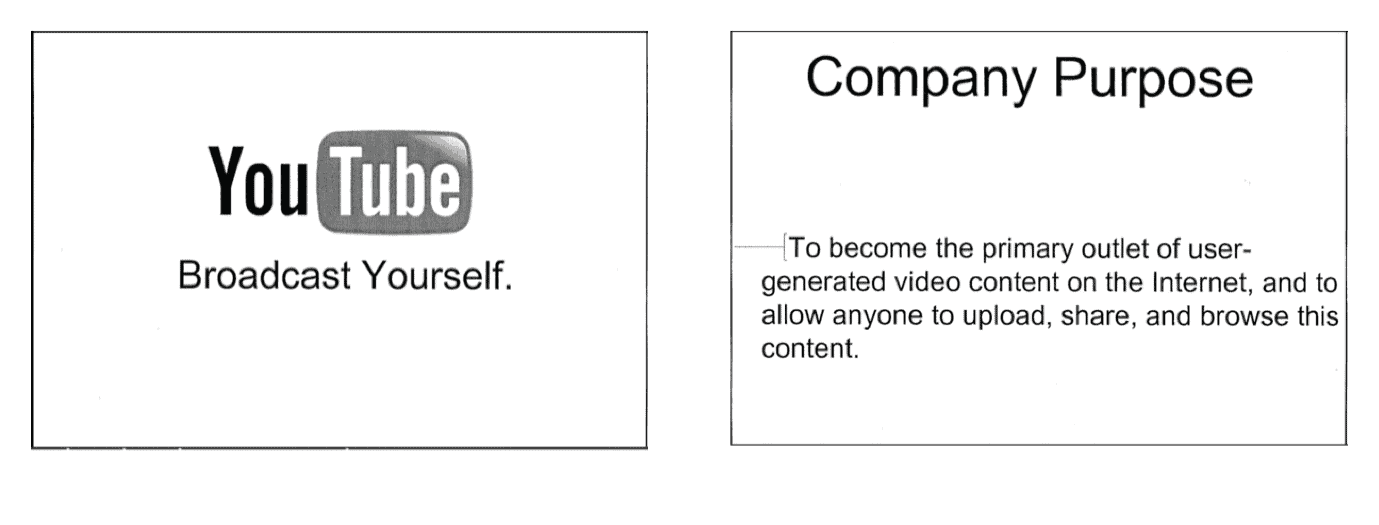
You can even be super creative using the two-slide intro. Just like Quora –

And if you want to just stick to the rules, you can go with what 500 Startups prefer –
A [product type] to help [target customer] with [#1 problem] by [#1 benefit] using our [secret sauce/differentiator].
Slide #2: Problem
“What problem are you trying to solve? Why is it a problem?”
The problem slide is where you present the status quo – the pain points that the customers have and how they affect them. The same problem is then translated into an untapped opportunity that the startup intends to capitalize on.
The Purpose of the Pitch Deck Problem Slide
The problem slide forms the spine of the startup. It is the answer to the questions –
- Who is suffering from the problem?
- What is the problem?
- How relevant is the problem?
- What is the current solution to the problem? What are the issues with the current solutions?
- Is it an obvious problem? If not, what’s the proof that such a problem exists?
How To Create A Problem Slide?
Develop the problem tree and divide your problems into sections, starting with the biggest problem. You can either use bullet points or complementing graphics to make the aesthetics better, but never include paragraphs in this slide.
Here’s an example of the pitch deck problem slide of YouTube –
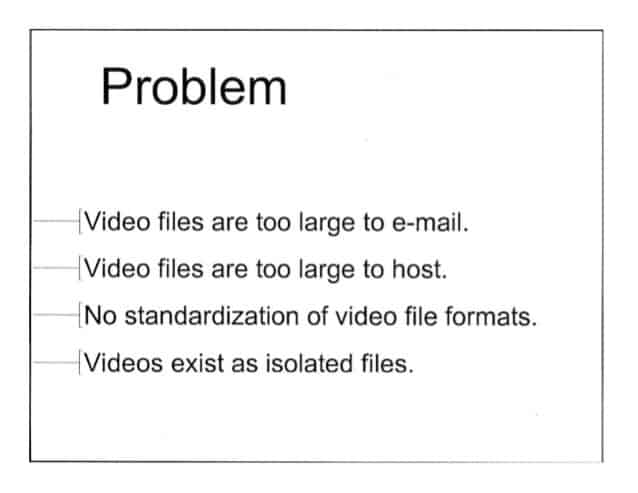
The slide clearly states the big problems that troubled YouTube’s target audience when it launched.
Uber used a similar strategy to develop its pitch deck’s problem slide. But since it had two segments of target audience it divided the problems into two different slides –

Quora, on the other hand, also included the companies that are trying to solve the problems.
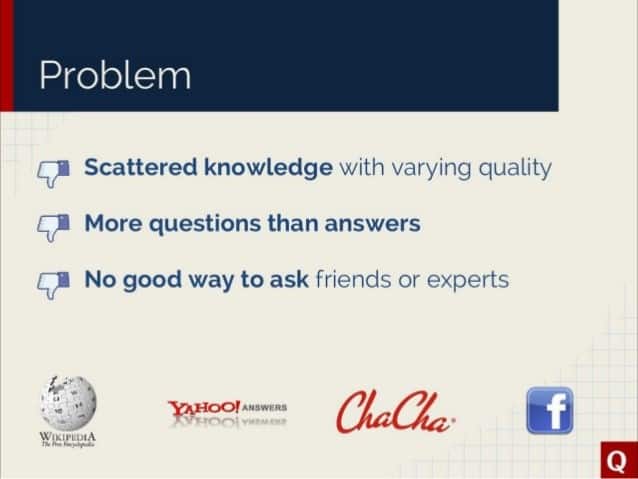
Make sure to keep your problem slide as simplified as possible –
Do include
- 100% verifiable claims, and
- Easy to read vocabulary
- Statements the investors can empathise with
Don’t include
- Complicated jargons,
- Debatable arguments,
- Questionable statements.
You need to make sure you don’t end up investors questioning your problem or the whole premise of the pitch will be doubted.
A common mistake most entrepreneurs make while preparing and presenting their pitch deck is not showing how the customers are deeply affected by the problem. Investors love to hear that the audience has been looking for a solution for some time, but haven’t been able to find a suitable solution till now.
Canva’s problem slide, which was a result of several trial and errors, was a visual masterpiece explaining the problem in detail which almost every designer or entrepreneur could empathise with.
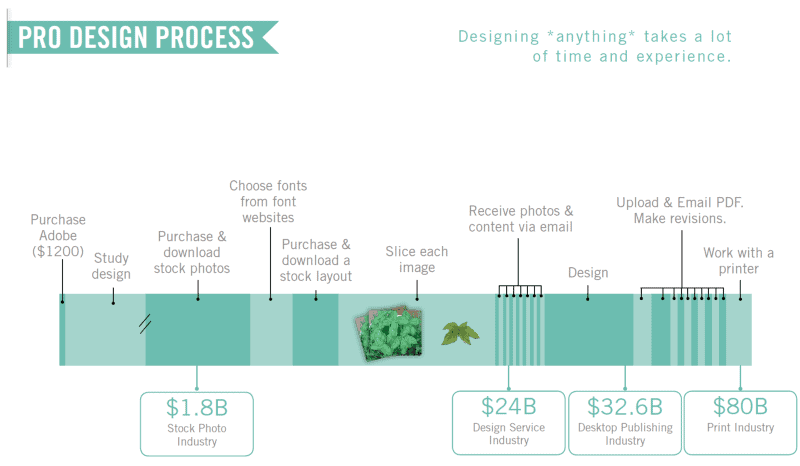
Slide #3: Solution
“How do you plan to solve the problem?”
The solution slide builds up on your eureka moment. This is the big reveal of your magic show.
On this slide you’ll address the problems stated on the previous slide and convert them into opportunities.
The Purpose of the Pitch Deck Solution Slide
The solution slide of the pitch deck is all about you –
- What do you offer?
- How do you solve the problems?
- What’s your value proposition?
- What benefits do you provide?
- What are your offering’s use cases?
How To Create A Solution Slide?
Solution slide is just an answer to the problems you’ve stated – what you have to offer and how it solves the problem.
It is when your product steals the spotlight.
You can either use text pointers to address to the problems, or you can also use images, gifs, and analogies to elaborate your points.
But make sure to keep the question of “how do you solve the problem?” at the highest priority.
Here’s how Sequoia Capital wants you to prepare your pitch deck’s solution slide –
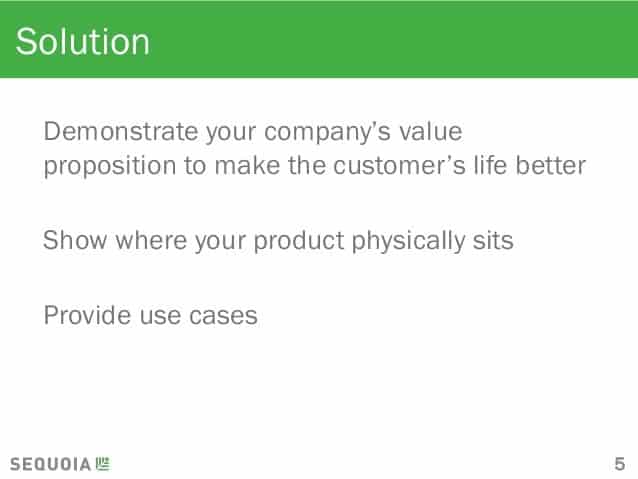
Airbnb aptly followed these guidelines in its solution slide.
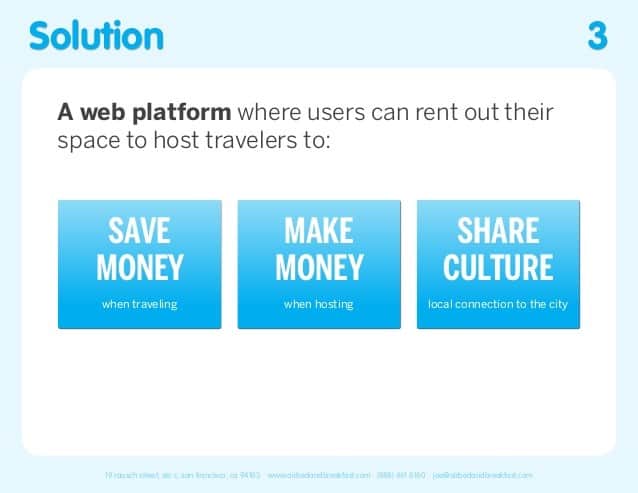
Remember, you don’t state how your product works in the solution slide. You just reveal the product and briefly describe how it addresses to problems you’ve stated in the previous slide.
Coinbase took a creative approach in explaining the same –

Avoid using tech jargons in your solutions slide. Even if you do use it, you can elaborate the same using the approach used by Quora –
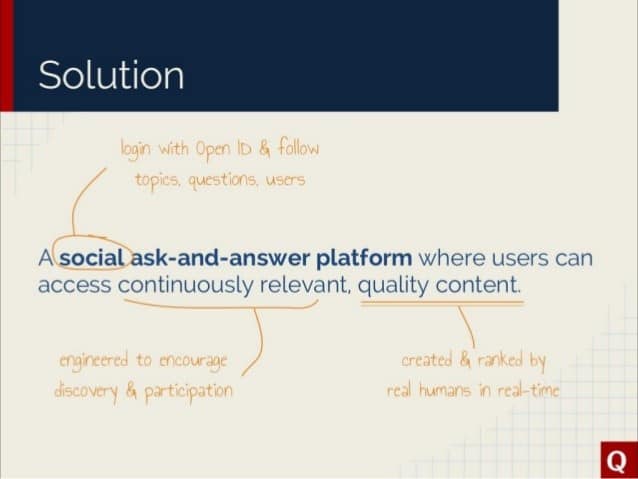
Another important point to note is to focus on the benefits and not on features. For example, instead of writing “a social networking oriented Q&A platform that operates on user-generated content”, Quora explained its solution in the form of benefits the user would understand – “A social ask and answer platform where users can access continuously relevant, quality content.”
A common mistake that fundraisers make is to over-complicate their pitch deck solution slides.
Never do that.
This slide is just to answer the question of what you do and how you solve problems. Don’t include heavy charts and graphs on this slide. Doing so may just overwhelm, confuse, and distract the investors away from your core function.
Slide #4: Why Now?
“Why is this solution needed right now? Give current market details.”
Startups are called startups because they disrupt the industries they operate in. The why now slide gives a reason why is this the right time to disrupt such industry and start the company. This slide is backed by data, trends, stats, and facts.
The Purpose of the Why Now Slide Of The Pitch Deck
The “why now” slide incorporates the current scenario, rising trends, the future predictions, and provides the evidence to why the market is changing and why is this the right time to start and grow your company.
This slide answers the following questions –
- What’s changing in the market and at what rate?
- Is the market growing? Why?
- Why is it an opportunity now?
Some examples include –
- Changing trends due to an unforeseen global event (like Coronavirus),
- Access to high speed internet,
- Increased smartphone penetration, etc.
The purpose of this slide is to make the investor believe that you understand the market well and knows what he’s doing.
Another (secret) purpose of this slide is to tell investors why is this the right time to invest in your startup (and not after 5 years).
How To Create A Why Now Slide?
The why now slide is where the data comes in. Analyse your target market, find and pin-point the stimulus that’s fuelling its growth and showcase the same to the investors.
Here’s the WeWork’s why now slide explaining the role of millennials in fuelling the growth of community-powered co-working market –

Besides this, you can use the following to support your argument of “why now” –
- Statistics from legit sources
- Personal experience and observation
- Quotes from experts in the market
- Existing players’ growth charts
Quora used a similar approach and used industry growth stats to state their “why now” –
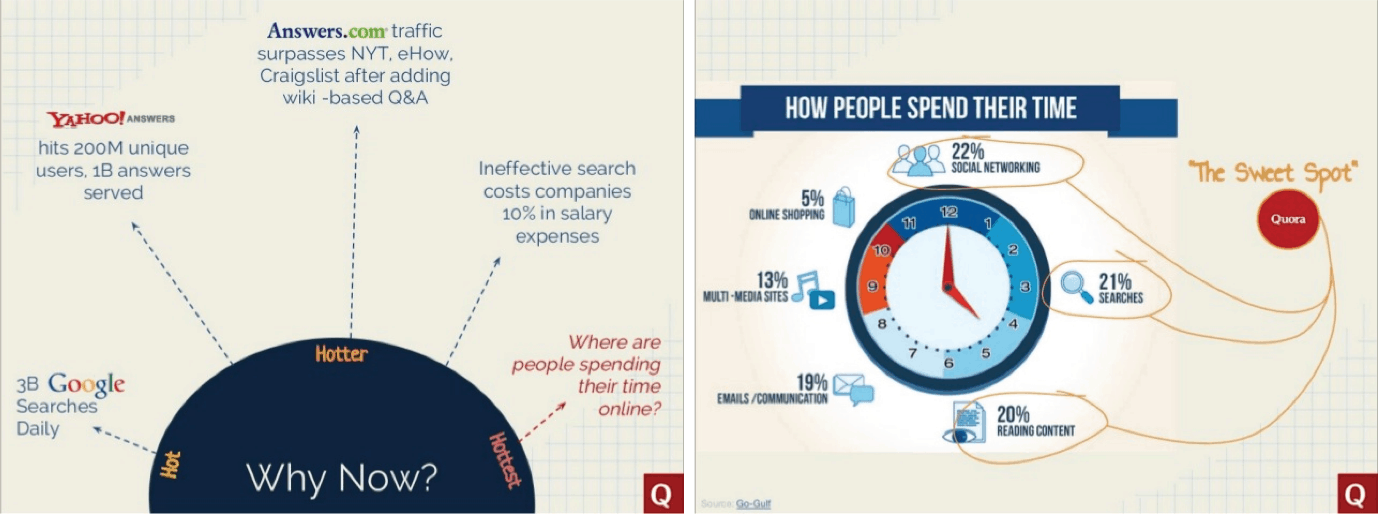
There’s a thin line between being real and superficial when presenting the why now slide of the pitch deck. Make sure –
- Your every argument is backed by correct fact or statistics, and
- The industry dynamics suit your argument.
Slide #5: Offering
“What is your offering and why is it special? What are the use-cases?”
While the solution section focuses on what you do and how you solve the problem, the offering slide talks about the “how does your offering work and what’s special about it?” aspect of your pitch deck.
Also called the product slide, this page includes screenshots, videos, and other aesthetics to showcase how the customer uses your product.
The Purpose Of The Pitch Deck Product Slide
The product slide is usually a visual representation of how the product works. It focuses on elaborating –
- How does your product work?
- How does your product look?
- How does your product feel?
- The use cases of your product, and
- The proprietary feature that sets your product apart
How To Create An Offering Slide?
Unlike solution slide where you’ve already proved that your solution is needed in the market, you don’t have to repeat your concept or answer the ‘why’ aspect of the offering here. This slide is all about showcasing your product. You explain the looks, features, key use-cases, functioning and key benefits.
Here’s how Uber used 6 slides to explain its offering to the investors –


The slide focuses on the front-end of your offering – how the customer will see and use it.
This can be done using screenshot images, videos, or an actual demonstration during the live presentation. Airbnb used images for the same –
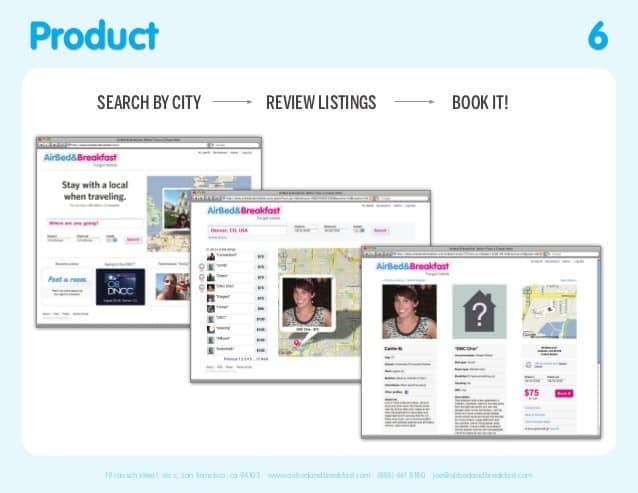
However, the trend of screenshots is usually replaced by usage of videos. This is because of the sole reason that screenshots are illegible.
Slide #6: Market
Is the market big enough for huge growth?
Now that you’ve revealed your product, you’ll have to answer the questions of “whether it has market for it?” and “why should I care about it?”.
Here you elaborate your market analysis to prove your worth in the market. Talk about the total market available and the total market you can have access to.
The Purpose of Pitch Deck’s Market Slide
The market slide is the turning point of the pitch. This is where investors see their investment’s future ROI.
You use slide to elaborate the market opportunity and how big your company can get. You answer the following questions through your pitch deck’s market slide –
- How do you segment your market?
- What’s the future market/potential for the product?
- Why does the investor should invest this early (will he see high returns for high risk)?
- How can you justify the investment you’re going to ask?
How To Create A Market Slide?
The only reason an investor invest in a startup early is because he expects substantially high results for high risks they take.
Even though the success can’t be guaranteed, you validate the market opportunity using numbers with legit sources. You provide them with the TAM, SAM, and SOM.
Airbnb uses this exact approach in its market size slide –
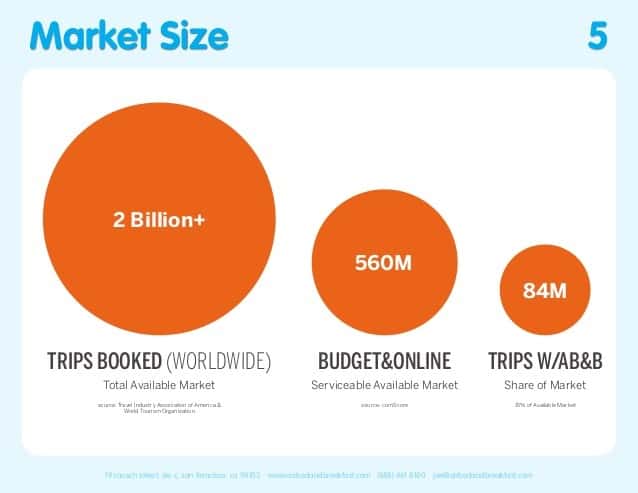
The market slide is vital, but don’t go on stating numbers without backing them with sources. And if you’ve done the calculation yourself, do share those calculations while presenting your deck.
It is also recommended to provide your investors with the segments of the market you plan to target –
- Initially,
- In the short and medium term, and
- In the long run.
Uber followed this approach –
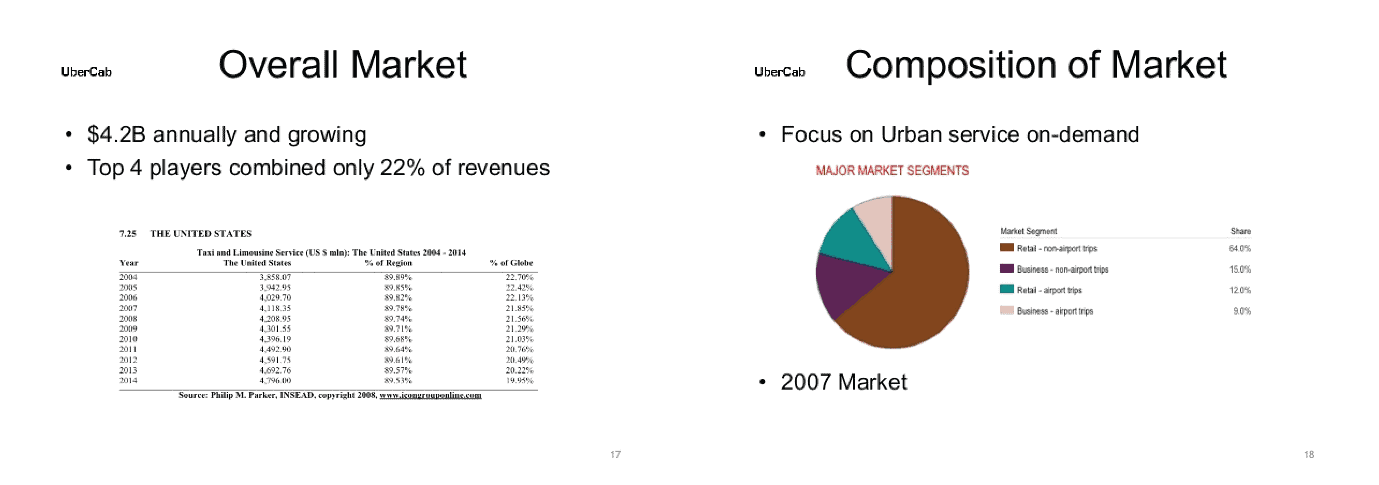
But make sure you don’t exaggerate or miscalculate your market size and scope. Often, depending much on the third-party high-level reports/estimations turn out to be miscalculated as it isn’t directed especially towards your offering. To make sure that the numbers are correct, you can back the top-down calculations with bottom-up calculations.
Slide #7: Competition
What are the alternative solutions to the problem you plan to solve? Where do you stand?
If you address a real problem, there is, for sure, someone who must have been addressing to your target customers, no matter if it is in the similar fashion or not. In this slide, you list every such player.
The Purpose of Pitch Deck’s Competition Slide
The competition slide has two objectives – To communicate to the investors that –
- Such a market does exist and people do look for other players to fulfil their needs, even though partially.
- The market isn’t overcrowded and that you can sufficiently differentiate your company.
- You have a plan to uniquely position your brand in the market.
How To Create A Competition Slide?
The competition slide includes the list of all the significant existing players in the market. It mentions what they do well, where do they lack, and how the customer perceives them. Moreover, the position the startup has succeeded in gaining or is willing to gain is also communicated using the competition slide.
You can use two types of competition mapping to communicate the same –
4 Quadrant Mapping
Also called perceptual mapping or market mapping, this competitive analysis map is used to demonstrate the existing positioning of the current players and how you differ your startup from them. It involves dividing the market into four segments and then populating them with the competitive companies indicating the position they acquire in the market.
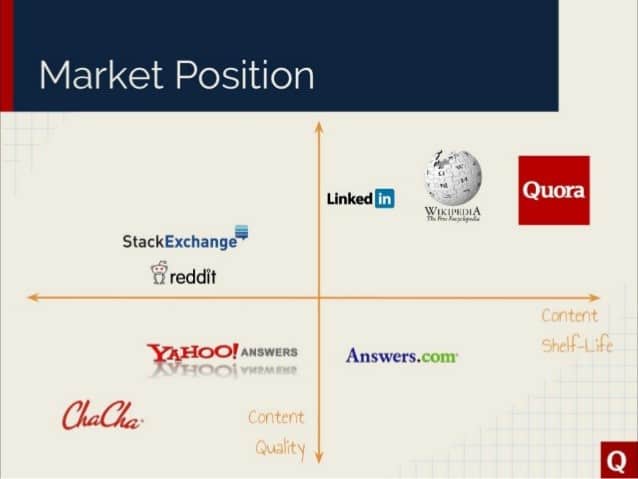
Airbnb used market mapping in its competition slide followed by the competitive advantage it had over them –
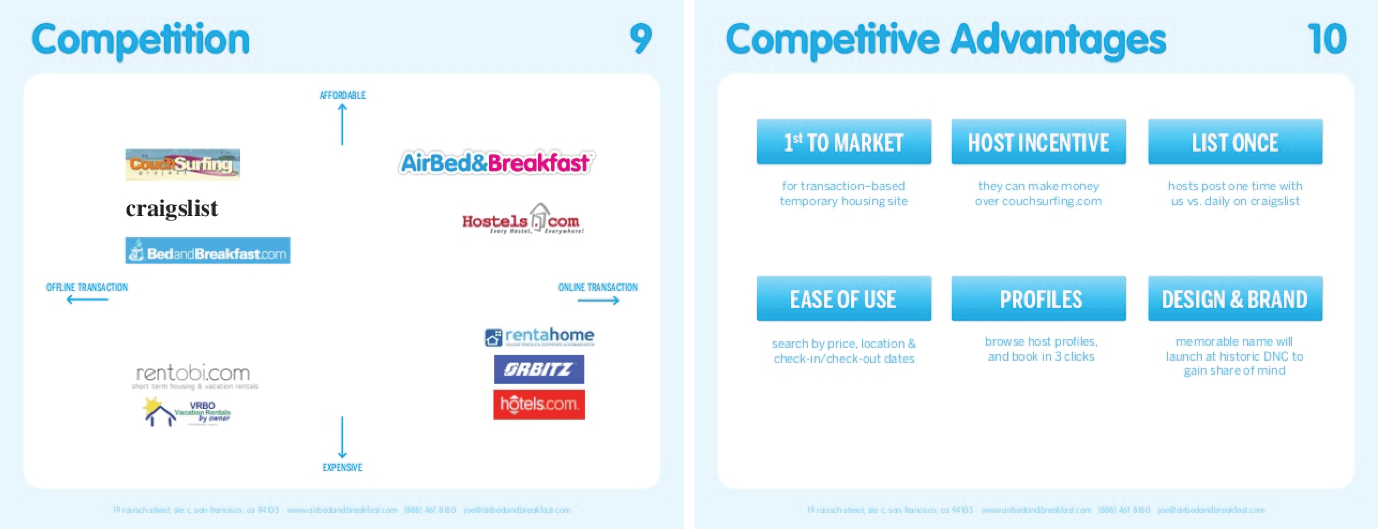
Petal Diagram
Coined by Steve Blank, the Petal Diagram is a new way of representing the competitive landscape of the startup by keeping it at the centre of the universe. The diagram is then divided into n number of market segment which are adjacent to the market the startup caters to. The segments are further filled with the capital the competitive companies raised to give an idea of how big the new market be.
Here’s an example of the petal diagram used in slack’s competitive landscape –
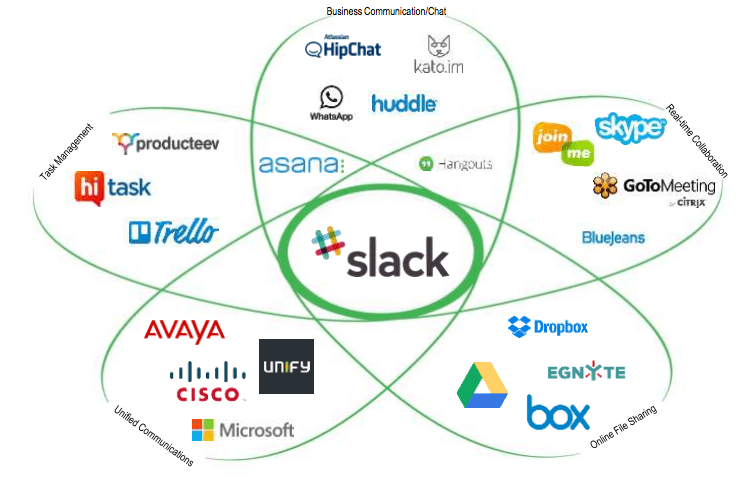
Previously, a new slide called “The Underlying Magic” was used to state the same but with the increased usage of such mapping graphs, you can cut short the drill and explain your value proposition and unique selling proposition in the same slide.
Slide #8: Traction
Can you prove your worth using numbers?
The traction slide is the proof that your business works and it is going in the right direction. You list your current progress along with the critical drivers for growth in this slide.
However, it is one such slide that needs to be updated very frequently depending upon the stage your startup is in.
The Purpose of Pitch Deck’s Traction Slide
The traction slide is vital if you are raising money for the growth stage. It focuses on communicating –
- You know your KPIs well and are working on it,
- The evidence that the product-market fit is validated and the startup is progressing
- That the growth is enough to see a good ROI
- Which numbers you need to improve over time (and how the funding will help you)
How To Create A Traction Slide?
The traction slide differ for different startups. It all depends on you KPIs and how you measure them. Usually, companies include the following in their traction slide –
- YoY, QoQ, or MoM Sales
- Net Promoter Score
- App Store Rankings
- Revenue
- Customer acquisition cost
- Customer lifetime value
- Average Sales Cycle
- Leads / Requests
- Monthly Recurring Revenue / Annual Recurring Revenue
- Average Order
- Conversion Rate
- Total Visitors
Make sure to showcase your KPIs visually.
Here’s how Reddit showcased its traction –

But what if you’re raising for the pre-seed and seed round and don’t have much traction yet?
Well, in that case, you can use this slide as an opportunity to show feedback from advisors or test users or the coverage that you’ve got till now. Like this –
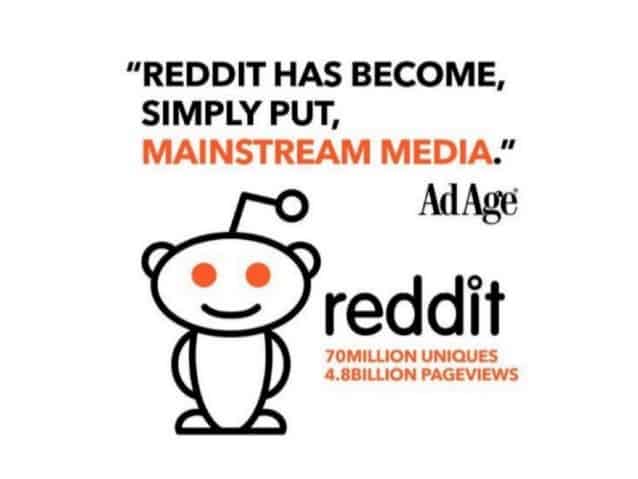
Don’t confuse your traction slide with your financials slide. You don’t show the expenses or other intricacies in this slide. You just talk about how you’ve been growing till now in the traction slide.
Slide #9: Business Model
How your product makes or will make money?
The business model is the backend of your offering. This is where you get technical and briefly explain how your startup operates and makes money.
The Purpose of Pitch Deck’s Business Model Slide
The primary purpose of the business model slide is to inform and explain the investors how your startup functions and generates revenue. This whole slide is a brief explanation of your business model canvas. You elaborate –
- Your key partners
- Your key activities
- Your key resources
- The channels you use to reach customers
- Your cost structures
- The revenue streams
How To Create A Business Model Slide?
Theoretically, the business model is just about how your startup operates and makes money. However, converting the huge business model into a single slide is a big task.
This is where you ask yourself – “what matters the most? What would be the investors biggest questions I need to answer here?”
The answer is your slide’s content.
Airbnb only included the revenue model in its business model slide.
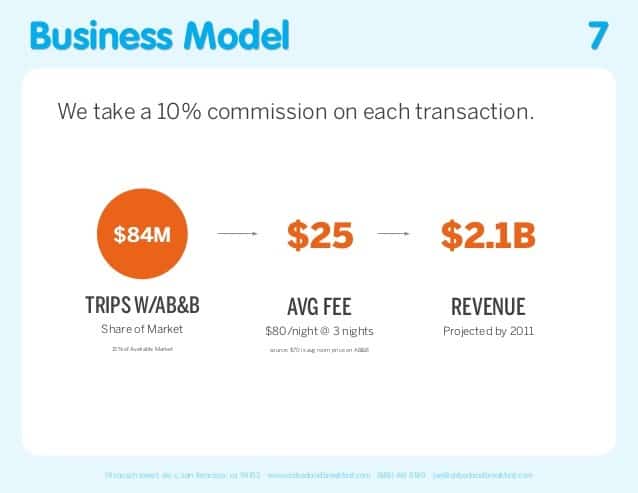
Reddit, on the other hand, elaborated its revenue generated sources – the types of advertisements on the platform.
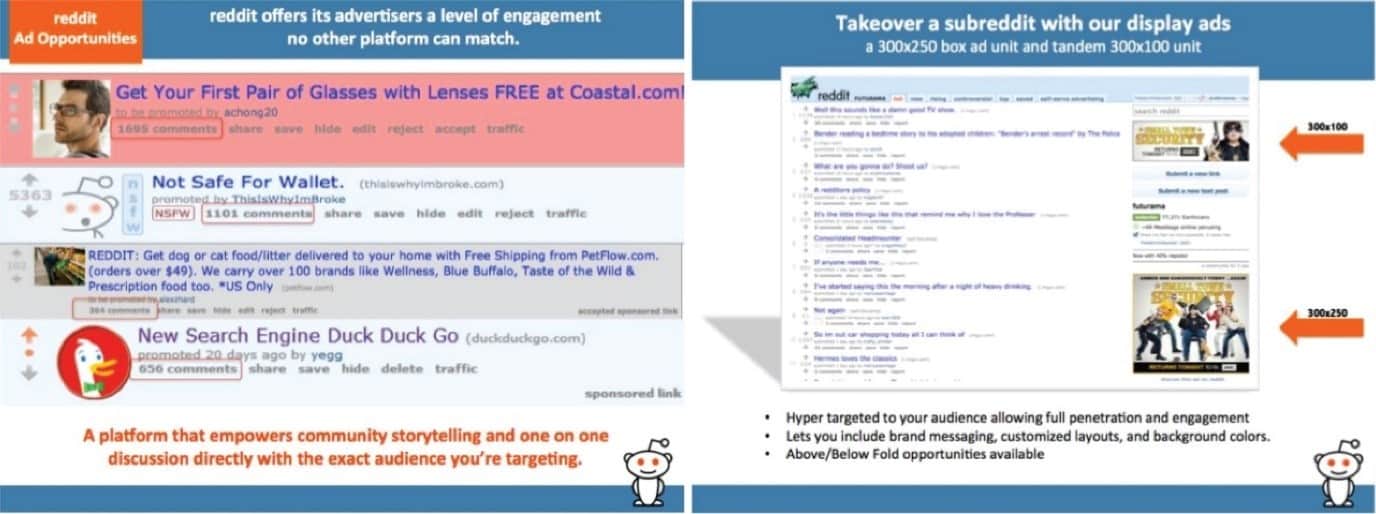
Besides this, Sequoia Capital also suggests that you can include your sales and distribution model and pipelines if you consider them to be out of the box.
Slide #10: Team
Who are the people behind the idea and its execution.
Early investments are divided in the ratio 50:50 between the idea and the team behind it. Unless and until you prove that you and your team are worth relying on, hardly any investor will provide you with investment.
The Purpose of Pitch Deck’s Team Slide
The main objective of the team slide of the pitch deck is build investor’s confidence in your team and your team’s skills. You showcase both your founding and operating team and inform the investors about your team’s –
- Education
- Experience
- Skills
- Accomplishments
You need to answer “What previous things in your team members’ lives could help you in tackle the business challenges?” through this slide.
How To Create A Team Slide?
Developing the team slide of the pitch deck is easy. You just include the people behind the idea along with their background and why have you selected them to be your partners or employees. This requires you to post their experience, education, etc.
Just like Quora’s Team slide –

But what if your team doesn’t have an experience worth mentioning about?
Well, in that case, take the team slide to be similar to the traction slide and mention how the team member has contributed to the startup. Just like how Buffer presented it –
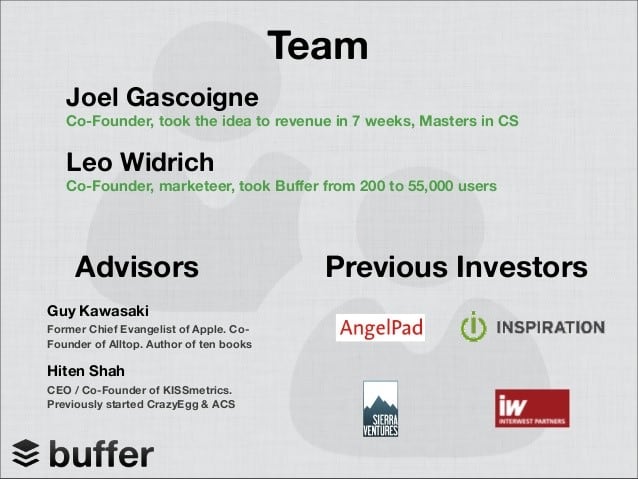
Slide #11: Financials
The current financials (P&L, growth, cash flow) and the growth plan.
The financials slide is a deep dive into the current and future numbers backed by your financial plan. In this slide, you can include EBIT calculation, the balance sheet, the income statement, and/or the cash flow statements, but don’t forget to include the projections.
The Purpose of Pitch Deck’s Financials Slide
The financials slide proves that you’re financially viable and are either profitable or on a verge to become profitable. You answer the question relating to –
- Your current viability – are you profitable? What are your costs? How do you utilise your money? Where do you get the money to run the business now? What do you do with the revenue now? How do you handle the cash flow?
- Your future viability – When do you expect to break-even? What are your three years financial forecast?
How To Create A Financials Slide?
The financials slide includes the revenues and expenditure of the current or previous year and the assumptions relating to the revenues and expenditures of the next three years, considering everything remains as expected.
You usually include cumulative EBIT (Earnings Before Interest and Tax) in this slide to show the investors how much money you’ll burn before becoming profitable.
This is how SEOMoz presented its estimated financials in its investment deck –
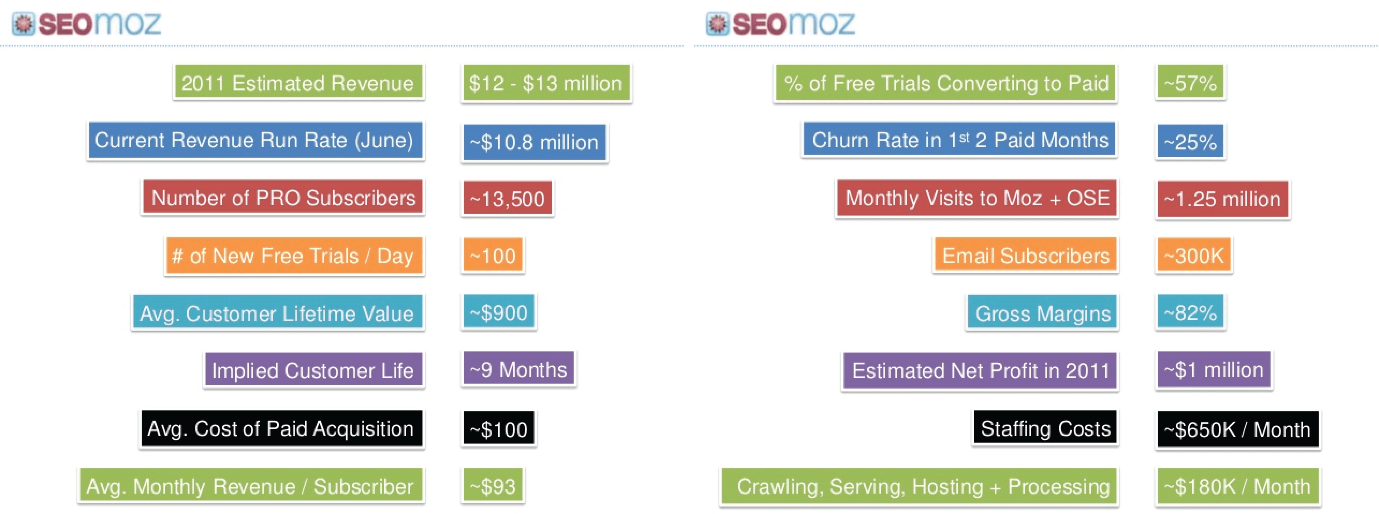
And this is the financial forecast slide of White Hat Jr, the company which was acquired by Facebook’s backed Byju’s in a $300 million all cash deal –
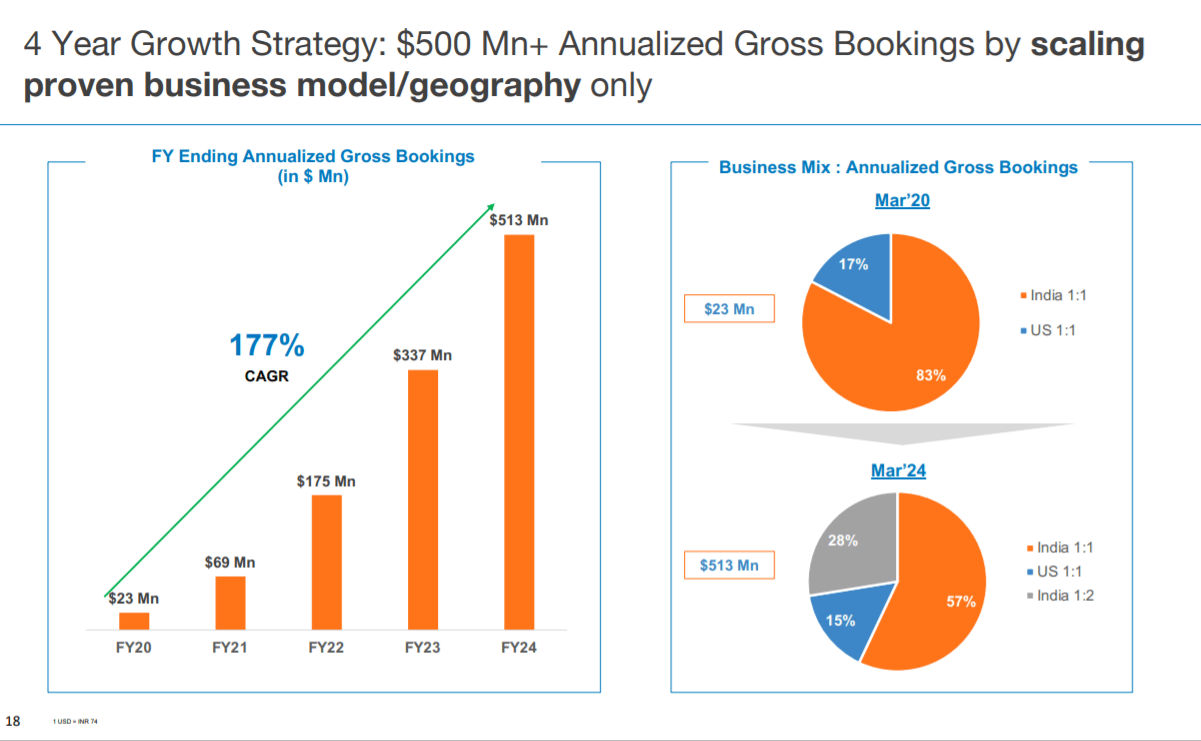
Slide #12: Ask
This is what we require from your side
This slide is where you get to business and explicitly state why you want investors to be on board. It makes you look aptly ambitious and shows that you have future plans for your business.
Usually, this is the last slide of your pitch deck but is often followed by a summary slide that summarises your pitch.
The Purpose of Pitch Deck’s Ask Slide
The ask slide answers the following questions –
- How much are you raising?
- How will you use the funds?
- What will you achieve with the funds?
How To Create An Ask Slide?
The ask slide is backed by your future plans and projections and should only be included if you have a reason to back the investment amount you ask for.
A good practice is to precede or succeed the slide with your business milestones just like Quora –
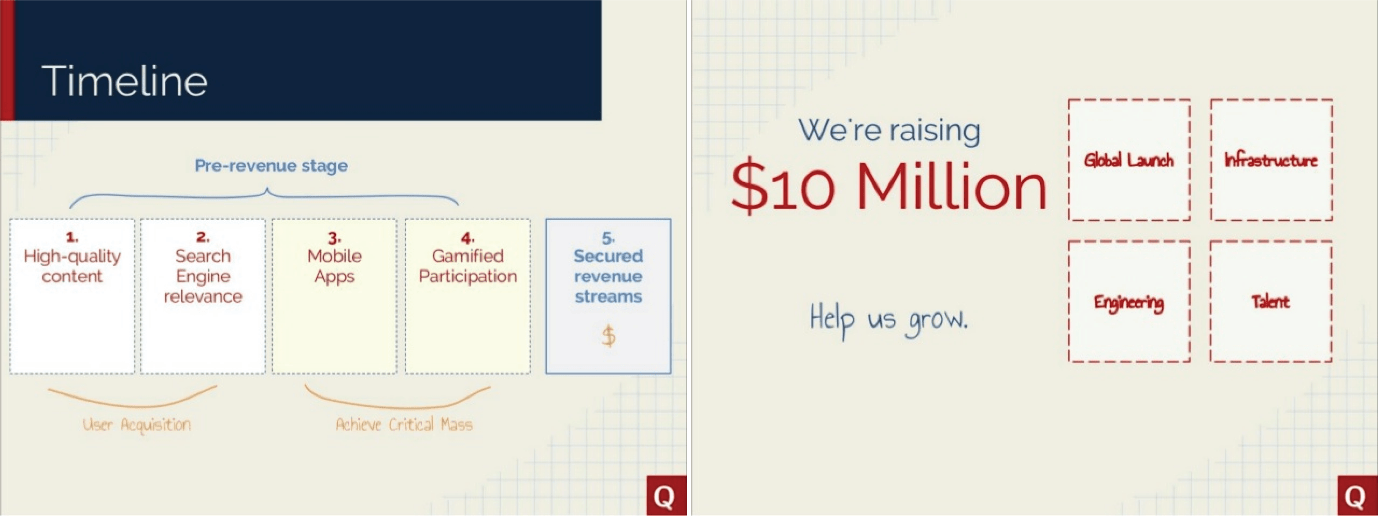
Explore The Chapters




